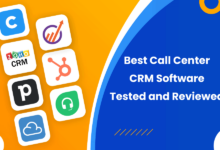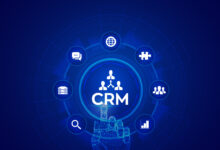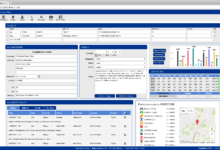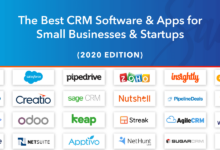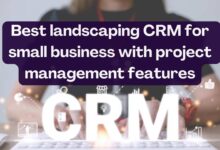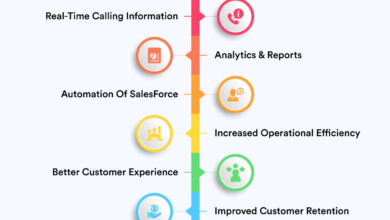CRM Demo: A Comprehensive Guide
CRM Demo: Navigating the world of Customer Relationship Management (CRM) software often begins with a demo. Understanding the various types of demos available—live, recorded, or self-guided—is crucial for making an informed decision. This guide explores the nuances of each demo type, helping you prepare effectively, analyze the content, and ultimately, evaluate its suitability for your business needs. We’ll delve into best practices, common pitfalls, and effective strategies to maximize the value of your CRM demo experience.
From identifying your specific business requirements to formulating insightful questions for the vendor, we’ll equip you with the knowledge to navigate the process confidently. We’ll also examine how to interpret the technical aspects presented during a demo, ensuring you can make a well-reasoned choice aligned with your organization’s goals. This comprehensive approach ensures you extract maximum value from the demo and make a strategic investment in your CRM solution.
Understanding CRM Demo Variations
Choosing the right CRM demo is crucial for effectively showcasing the platform’s capabilities and addressing potential client needs. Different demo styles cater to varying preferences and business contexts, impacting the overall effectiveness of the sales process. Understanding these variations is key to maximizing the impact of your CRM presentation.
Types of CRM Demos
CRM demos come in various formats, each designed to serve a specific purpose and audience. The selection of demo type depends heavily on factors such as prospect availability, technical capabilities, and the complexity of the CRM system itself.
- Live Demos: These involve a real-time presentation by a sales representative, allowing for interactive Q&A and customized demonstrations based on the prospect’s specific needs. Live demos are highly effective for building rapport and addressing complex queries.
- Recorded Demos: Pre-recorded demos offer a consistent message and can be easily shared with multiple stakeholders. They are ideal for prospects who prefer asynchronous communication or have limited time for live sessions. These can also be used to supplement a live demo, covering functionalities not easily demonstrated in real-time.
- Self-Guided Demos: These interactive demos allow prospects to explore the CRM platform at their own pace. They often include guided tutorials and interactive elements, empowering prospects to experience the software independently. This approach is particularly suitable for prospects who prefer hands-on learning.
Industry Suitability of Demo Types
The best demo type varies depending on the industry and the prospect’s preferences.
- Live Demos: Industries with complex sales cycles, such as enterprise software or financial services, often benefit from live demos that allow for detailed discussions and customized demonstrations. The ability to answer immediate questions is critical in these contexts.
- Recorded Demos: Industries with large sales teams or geographically dispersed prospects, such as e-commerce or marketing agencies, often find recorded demos efficient for consistent messaging and broad outreach. The time-saving aspect is highly beneficial in these situations.
- Self-Guided Demos: Industries with a younger, tech-savvy audience, such as SaaS or e-learning, may find self-guided demos more engaging. This approach allows prospects to learn at their own pace and explore the platform independently.
Key Features Showcased in a Typical CRM Demo
A typical CRM demo highlights core functionalities crucial for business operations. These usually include contact management, lead tracking, sales pipeline visualization, reporting and analytics, and integration capabilities. The specific features demonstrated will depend on the CRM platform and the prospect’s needs. For example, a demo for a small business might focus on contact management and basic sales tracking, while a demo for a large enterprise might emphasize advanced analytics and custom reporting.
Comparison of CRM Demo Offerings
The following table compares the demo offerings of three popular CRM platforms: Salesforce, HubSpot, and Zoho CRM.
| CRM Platform | Demo Type | Key Features | Target Audience |
|---|---|---|---|
| Salesforce | Live, Recorded, Self-Guided | Sales Cloud, Service Cloud, Marketing Cloud, AppExchange integrations | Large enterprises, mid-sized businesses |
| HubSpot | Live, Recorded, Self-Guided | Sales Hub, Marketing Hub, Service Hub, CRM, integrations with other HubSpot tools | Small businesses, mid-sized businesses, marketing and sales teams |
| Zoho CRM | Live, Recorded, Self-Guided | Contact management, lead management, sales pipeline management, reporting and analytics, integrations with other Zoho apps | Small businesses, mid-sized businesses, various industries |
Preparing for a CRM Demo
A successful CRM demo hinges on thorough preparation. By proactively addressing your needs and expectations, you can maximize the value of the demonstration and ensure it aligns with your business goals. Failing to prepare adequately can lead to wasted time and a lack of clarity regarding the CRM’s suitability for your organization.
Questions to Ask Before a CRM Demo
Asking the right questions before attending a CRM demo is crucial for a productive session. This pre-demo preparation ensures your time is used effectively and helps you focus on the features most relevant to your company. This proactive approach allows for a more tailored and insightful demonstration.
- What specific functionalities will be showcased during the demo?
- Will the demo incorporate real-world data or use sample data?
- What level of customization is possible within the CRM?
- What are the integration capabilities with our existing systems?
- What is the expected timeline for implementation and training?
Defining Specific Business Needs Before a CRM Demo
Clearly defining your business needs before a CRM demo is paramount. This ensures the demo focuses on features that directly address your challenges and opportunities, rather than showcasing irrelevant functionalities. A well-defined scope allows for a more targeted and effective evaluation.
A company seeking to improve customer retention, for instance, should focus on features related to customer interaction management, support ticketing, and automated follow-ups. Conversely, a sales-focused organization would prioritize features such as lead management, sales pipeline tracking, and forecasting tools. This targeted approach ensures the demo highlights the aspects most crucial to the company’s success.
Sample Agenda for a Productive CRM Demo Session
A structured agenda ensures a focused and productive CRM demo. This ensures all key aspects are covered within the allotted time, preventing any crucial information from being overlooked. The agenda should be shared with the vendor beforehand to ensure alignment and efficiency.
- Introduction and Overview (5 minutes)
- Demonstration of Key Features (20 minutes)
- Q&A Session (15 minutes)
- Discussion of Implementation and Support (10 minutes)
- Next Steps and Call to Action (5 minutes)
Preparing Data for a Personalized CRM Demo
Providing your own data for a personalized CRM demo allows for a more realistic and relevant demonstration. This ensures the demo accurately reflects your specific business processes and data structure. The vendor can then demonstrate how the CRM handles your data, highlighting its capabilities in a context you readily understand.
- Identify Key Data Points: Determine the essential data points relevant to your business processes, such as customer information, sales data, or support tickets. For example, a retail business might prioritize customer purchase history, while a tech company might focus on support ticket resolution times.
- Data Cleaning and Formatting: Ensure your data is clean, consistent, and formatted appropriately for import into the CRM. This might involve removing duplicates, correcting inconsistencies, and standardizing data formats. This ensures accurate and reliable results during the demo.
- Data Subset Selection: Select a representative subset of your data for the demo. Using your entire database might be impractical, so choose a sample that accurately reflects the characteristics of your complete data set. This avoids overwhelming the demo with unnecessary information.
- Data Anonymization: Anonymize sensitive data to protect privacy and comply with regulations. This might involve removing personally identifiable information (PII) or using pseudonyms to represent real data without compromising confidentiality. This ensures compliance with data protection laws.
- Data Transfer Method: Determine the best method for transferring your data to the vendor, such as a secure file transfer protocol (SFTP) or a cloud-based storage solution. This ensures secure and efficient data exchange.
Analyzing CRM Demo Content
Effective CRM demos hinge on a well-structured presentation that resonates with the audience and clearly showcases the software’s capabilities. Analyzing the content of various demos allows for a deeper understanding of successful sales strategies and presentation techniques. This analysis will focus on common sales pitches, visual presentation styles, delivery methods, and the interpretation of technical specifications.
Common Sales Pitches in CRM Demos
Successful CRM demos often incorporate several key sales pitches to highlight the software’s value proposition. These pitches frequently focus on increased efficiency, improved customer relationships, and enhanced revenue generation. For instance, a common pitch might emphasize streamlined workflows, resulting in reduced administrative time and increased sales productivity. Another might showcase the improved customer experience facilitated by personalized communication and better data management, leading to increased customer retention and loyalty. Finally, demos often highlight reporting and analytics capabilities, demonstrating how the CRM can provide actionable insights for strategic decision-making and ultimately drive revenue growth. These pitches are usually supported by concrete examples and quantifiable results wherever possible.
Visual Presentation Styles in CRM Demos
The visual style of a CRM demo significantly impacts its effectiveness. Some demos favor a clean, minimalist aesthetic with a focus on clear data visualization and concise explanations. Others adopt a more dynamic approach, utilizing animations, interactive elements, and engaging visuals to maintain audience interest. A comparison reveals that the choice of style often depends on the target audience and the complexity of the software being demonstrated. For instance, a demo for a technical audience might prioritize detailed screen recordings and technical specifications, while a demo for a less technical audience might favor a simpler, more visually appealing presentation with a focus on user experience. The effectiveness of each style depends on the specific context and audience.
Effectiveness of CRM Demo Delivery Methods
Different delivery methods for CRM demos offer distinct advantages and disadvantages. Screen sharing, a common method, allows for real-time interaction and direct demonstration of software features. However, it can be less engaging than a pre-recorded video, which allows for a more polished and controlled presentation. Video conferencing offers a balance, providing real-time interaction while also allowing for visual aids and a more personalized experience. The choice of method should be based on the audience’s size, technical capabilities, and the desired level of interactivity. For example, a large-scale webinar might benefit from a pre-recorded video, while a smaller, more focused presentation might leverage screen sharing for a more interactive experience.
Interpreting Technical Specifications in a CRM Demo
Understanding the technical specifications mentioned in a CRM demo is crucial for assessing the software’s capabilities and suitability for specific needs. These specifications often include details about integration capabilities, scalability, security features, and platform compatibility. For example, a demo might highlight the CRM’s ability to integrate with existing marketing automation tools or its scalability to accommodate a growing customer base. Interpreting these specifications requires a clear understanding of the organization’s technical infrastructure and requirements. A strong understanding of these aspects enables informed decision-making regarding the suitability of the CRM for the specific business context. For instance, understanding the CRM’s security features (e.g., encryption, access controls) is crucial for organizations handling sensitive customer data.
Post-Demo Evaluation
A successful CRM demo isn’t just about showcasing features; it’s about understanding its fit within your specific business context. Post-demo evaluation is crucial for making informed decisions and ensuring the chosen CRM solution truly addresses your needs. This process involves documenting key takeaways, strategizing effective follow-up, and meticulously assessing alignment with your business objectives.
CRM Demo Evaluation Template
A structured approach to documenting post-demo insights is essential. The following template facilitates a comprehensive review, enabling a fair comparison across different CRM demonstrations.
| Aspect | Rating (1-5) | Notes |
|---|---|---|
| Ease of Use | ||
| Feature Functionality | Specific features demonstrated and their effectiveness. | |
| Integration Capabilities | Integration with existing systems (e.g., marketing automation, accounting software). | |
| Customization Options | Flexibility to tailor the CRM to specific business processes. | |
| Reporting & Analytics | Data visualization capabilities and reporting features. | |
| Vendor Support & Training | Responsiveness, expertise, and training resources offered. | |
| Cost & Pricing | Pricing model, implementation costs, and ongoing maintenance fees. | |
| Overall Impression | Summary of the overall experience and potential fit. |
Effective Follow-Up Strategies
Following up promptly and strategically after a CRM demo significantly increases the chances of a successful implementation. This involves a multi-faceted approach that balances proactive communication with respectful consideration of the prospect’s timeline.
- Send a personalized thank-you email summarizing key discussion points and reiterating the value proposition of the CRM.
- Schedule a follow-up call to address any outstanding questions or concerns and delve deeper into specific functionalities.
- Provide additional resources such as case studies, testimonials, or white papers that demonstrate the CRM’s success in similar businesses.
- Offer a personalized demo tailored to specific business challenges identified during the initial presentation.
- Propose a trial period or pilot program to allow for hands-on experience with the CRM within the prospect’s own environment.
Assessing Alignment with Business Goals
The primary objective of a CRM demo should be to demonstrate its alignment with the organization’s strategic objectives. This necessitates a thorough pre-demo assessment of business needs and a post-demo analysis to determine if the CRM adequately addresses those needs.
For example, a company aiming to improve customer retention should evaluate whether the CRM provides robust tools for managing customer interactions, tracking satisfaction levels, and identifying at-risk customers. A sales-focused company should assess the CRM’s lead management, sales pipeline tracking, and forecasting capabilities.
Criteria for Evaluating CRM Demo Quality
Evaluating the quality of a CRM demo goes beyond simply assessing the software’s features. It encompasses the entire presentation and the vendor’s approach.
- Clarity and Organization: Was the demo well-structured, easy to follow, and free of technical jargon?
- Relevance to Business Needs: Did the demo directly address the organization’s specific requirements and pain points?
- Interactive Engagement: Did the demo allow for questions, feedback, and interactive exploration of the software?
- Real-World Examples: Were real-world examples and case studies used to illustrate the CRM’s capabilities and benefits?
- Technical Proficiency: Was the presenter knowledgeable and able to handle technical questions effectively?
- Professionalism and Communication: Was the presenter professional, courteous, and responsive to questions?
Illustrative Examples of CRM Demos
Effective CRM demos are crucial for showcasing a system’s capabilities and securing sales. Different demo styles cater to various needs and preferences, each with its own strengths and weaknesses. The following examples illustrate the impact and variations of CRM demos in real-world scenarios.
Live CRM Demo Impacting a Sales Decision
A large marketing agency, struggling with inefficient lead management, was considering implementing a new CRM. During a live demo, the vendor showcased real-time lead tracking, automated email sequences, and detailed reporting capabilities. The agency’s sales team, witnessing the seamless integration with their existing marketing automation platform and the potential for increased conversion rates through personalized outreach, immediately recognized the value proposition. The live demonstration of these features, directly answering their concerns about data visibility and workflow optimization, significantly influenced their decision to purchase the CRM system, resulting in a contract exceeding $50,000. The ability to ask questions and see immediate responses to their specific needs solidified their confidence in the system’s practicality and effectiveness.
Benefits and Drawbacks of Recorded CRM Demos
Recorded CRM demos offer accessibility and convenience. They allow prospects to review the presentation at their leisure, share it with colleagues, and revisit specific features. However, the lack of real-time interaction limits the opportunity for immediate clarification and personalized adjustments. For example, a recorded demo might showcase lead scoring, but it cannot dynamically respond to a prospect’s question about integrating with their unique lead generation software. The benefits include cost-effectiveness (no need for a live presenter) and consistent messaging, while drawbacks include limited engagement and the inability to tailor the demo to specific prospect needs.
Hypothetical Self-Guided CRM Demo Experience
Imagine a prospect navigating a website dedicated to a new CRM. Upon entering, they’re greeted with an interactive tour. This tour guides them through key features, such as contact management, deal tracking, and reporting dashboards. Each section provides brief explanations, accompanied by short, engaging video clips demonstrating the functionality. The prospect can pause, rewind, and jump to specific sections based on their interest. They can also access downloadable resources like case studies and white papers. Throughout the experience, a chat function is available to connect with a support representative if they have any questions or require further assistance. This self-guided approach provides flexibility and control, allowing prospects to explore the CRM at their own pace.
Description of an Ideal CRM Demo
An ideal CRM demo starts with a concise overview of the prospect’s business challenges and how the CRM addresses them. The narrative then progresses through a logical sequence, showcasing key features with clear visual aids. Imagine a screen recording showing a user adding a new contact, then seamlessly transitioning to a visualization of that contact’s interactions with the company over time, including email exchanges, support tickets, and sales opportunities. The visual elements should be crisp and uncluttered, highlighting key information without overwhelming the viewer. The demo presenter should maintain a conversational tone, actively engaging the audience with questions and anecdotes, emphasizing real-world application rather than technical specifications. Finally, the demo should conclude with a clear call to action, outlining next steps and offering opportunities for further engagement. The entire experience should feel personalized and relevant to the prospect’s specific needs, leaving them with a clear understanding of the CRM’s value and its potential to improve their business outcomes.
Last Word
Ultimately, a successful CRM demo is more than just a software showcase; it’s a collaborative process of discovery and evaluation. By approaching the demo with a clear understanding of your needs, a structured approach to information gathering, and a well-defined evaluation framework, you can significantly improve your chances of selecting a CRM system that perfectly aligns with your business objectives. Remember to actively participate, ask pertinent questions, and meticulously document your findings to ensure a smooth transition to your chosen CRM solution.
